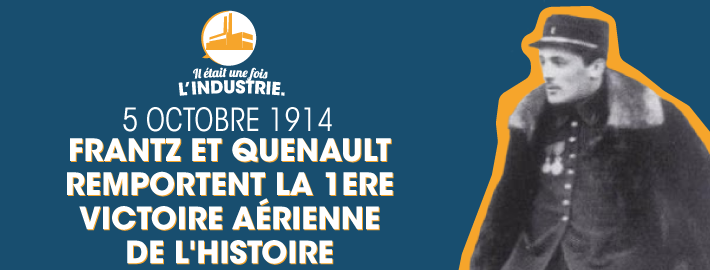GLOBAL
INDUSTRIE
News
Share on

5 October 1914: the French pilots Frantz and Quenault win the first aerial dogfight in history
This week, we look back to the first military exploit of a then very recent industrial invention used in an armed conflict, and not just any conflict because we are talking about World War I.
A NEW MODE OF COMBAT
When the war began in the summer of 1914, aviation was still in its infancy, the Wright Brothers’ first flight having taken place only in 1903. Nevertheless, immediately realising its military importance, France equipped itself with aircraft for reconnaissance purposes as early as 1909.
Although, on the 1st of November 1911, during the war against Turkey, the Italian aviator Giulio Gavotti was the first to carry out a bombing, in Libya, by throwing four hand grenades from his plane, no aerial combat had yet taken place when the world war began: the first aircraft to be shot down was another Italian plane in 1912, but it was brought down by a machine gun on the ground.
ACE OF ACES
At just 24, Sergeant Joseph Frantz was anything but a novice. After obtaining his pilot’s licence in 1911, he had worked as a test pilot and had distinguished himself in his first year by flying his plane between the towers of Chartres cathedral. It was thus only logical that from the very beginning of the war he was assigned to the V.24 squadron, where his mechanic was a certain Louis Quenault, aged 22. Together, they had already been involved in eleven dogfights but, armed only with revolvers, had not succeeded in shooting down their opponents…
On this sunny morning of Monday the 5th of October 1914, the two men were assigned a mission to drop six bombs over the German lines stationed around the Fort of Brimont, near Reims. Probably chastened by his previous experiences, and without his superiors’ consent, Joseph Frantz asked for Louis Quenault, seated behind him with the bombs in their sturdy lightweight steel biplane Voisin II, to also be equipped with a machine gun. This was installed on a tripod by the builder of the aircraft himself, Gabriel Voisin.
AN EPIC FIGHT
While flying back over French lines after completing their mission, they came face to face with a German plane flown by Sergeant Wilhelm Schlichting, assisted by Lieutenant Fritz von Zangen, who was armed only with a rifle.
Remembering from his previous experiences that an aerial dogfight can only be won by getting as close as possible to the opponent for optimum firing accuracy, Joseph Frantz positioned himself behind the enemy, at a slightly higher altitude, to make the conditions as optimal as possible for Louis Quenault. The sequence lasted more than a quarter of an hour, the machine gun jamming and the enemy plane attempting to escape by flying in a spiral. Eventually, however, it was hit and crashed near the Marne village of Jonchery-sur-Vesle, to cheers from the French troops.
The two men, who were destined to survive both world wars, had just won the first aerial dogfight in history. This led to Louis Quenault receiving the Military Medal and Joseph Frantz, who already had one, being made a Knight of the Legion of Honor, their exploit, reported in France’s leading newspapers, making them two of the first heroes of this deadly conflict.
"In the air a machine ceases to be a mechanical assembly; it comes alive and expresses the temperament of the pilot"– Captain Ross Smith
OTHER EVENTS WHICH HAPPENED THIS WEEK:
- 4 October (1957): the Soviet Union launches Sputnik 1, the first artificial Earth satellite
- 5 October (2016): the Nobel Prize for Chemistry is awarded to the Frenchman Jean-Pierre Sauvage, the Scotsman James Fraser Stoddart and the Dutchman Bernard Lucas Feringa for their work on the design and synthesis of molecular machines
- 6 October (1873): the American balloonist Washington Harrison Donaldson fails in his attempt to fly from the United States to Europe
- 7 October (1870): Léon Gambetta leaves Paris in a balloon to travel to Tours and continue to lead the fight against the Prussian armies
- 7 October (1952): the American inventor Joseph Woodland patents the barcode
- 9 October (1890): first flight of the Éole, a plane built by the French aviation pioneer Clément Ader, which flies 20 cm above the ground over fifty meters
- 10 October (1957): fire in Britain’s Windscale nuclear power plant
2021.10.04